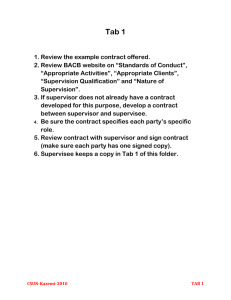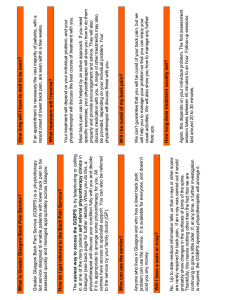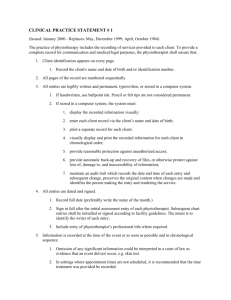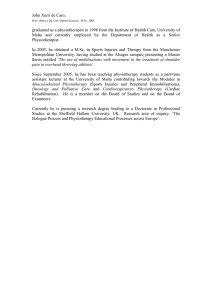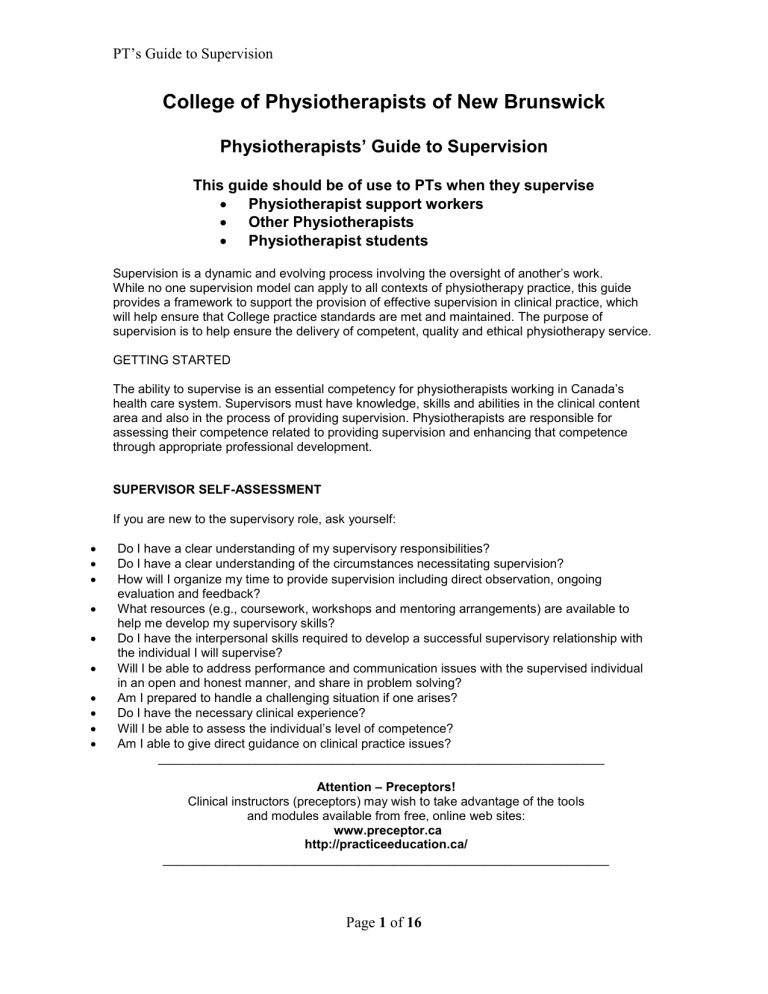
PT’s Guide to Supervision College of Physiotherapists of New Brunswick Physiotherapists’ Guide to Supervision This guide should be of use to PTs when they supervise Physiotherapist support workers Other Physiotherapists Physiotherapist students Supervision is a dynamic and evolving process involving the oversight of another’s work. While no one supervision model can apply to all contexts of physiotherapy practice, this guide provides a framework to support the provision of effective supervision in clinical practice, which will help ensure that College practice standards are met and maintained. The purpose of supervision is to help ensure the delivery of competent, quality and ethical physiotherapy service. GETTING STARTED The ability to supervise is an essential competency for physiotherapists working in Canada’s health care system. Supervisors must have knowledge, skills and abilities in the clinical content area and also in the process of providing supervision. Physiotherapists are responsible for assessing their competence related to providing supervision and enhancing that competence through appropriate professional development. SUPERVISOR SELF-ASSESSMENT If you are new to the supervisory role, ask yourself: Do I have a clear understanding of my supervisory responsibilities? Do I have a clear understanding of the circumstances necessitating supervision? How will I organize my time to provide supervision including direct observation, ongoing evaluation and feedback? What resources (e.g., coursework, workshops and mentoring arrangements) are available to help me develop my supervisory skills? Do I have the interpersonal skills required to develop a successful supervisory relationship with the individual I will supervise? Will I be able to address performance and communication issues with the supervised individual in an open and honest manner, and share in problem solving? Am I prepared to handle a challenging situation if one arises? Do I have the necessary clinical experience? Will I be able to assess the individual’s level of competence? Am I able to give direct guidance on clinical practice issues? ________________________________________________________________ Attention – Preceptors! Clinical instructors (preceptors) may wish to take advantage of the tools and modules available from free, online web sites: www.preceptor.ca http://practiceeducation.ca/ ________________________________________________________________ Page 1 of 16 PT’s Guide to Supervision ELEMENTS OF AN EFFECTIVE SUPERVISION PLAN Supervision plans are a key tool for effective supervision and should be reviewed and refined regularly. The supervised individual (for the purposes of this guide they will be referred to as “supervisee”) should be involved in the plan’s development and clearly understand the context and manner in which supervision will occur. At a minimum, supervision plans should include: 1. Responsibilities 2. Strategies 3. Evaluation 4. Feedback 1. RESPONSIBILITIES A clearly defined list of responsibilities is essential. Responsibility descriptions can, and often, enhance existing supervision policies and procedures for an employment facility, educational or contractual agreement. A list of key regulatory responsibilities follows below. Your employment facility or organization may have others. Key Regulatory Responsibilities Physiotherapist Supervisee ● only supervises activities they themselves are competent to perform ● understands extent of responsibilities including boundaries established by supervisor ● develops supervision plan considering patient’s needs, service delivery model and supervisee’s education, training and experience ● performs delegated tasks appropriately and effectively ● discusses supervision and intervention plan with supervisee before assigning patient care responsibilities ● develops open, honest and respectful relationship with supervisor ● integrates learning ● upholds regulatory responsibilities if and when applicable ● communicates openly and honestly with supervisee on a regular basis ● reflects upon learning needs and participates in appropriate professional development ● conducts regular evaluations to ensure supervisee is delivering competent, quality and ethical physiotherapy services ● obtains informed consent from patient, guardian or substitute decision-maker regarding supervisee’s involvement in delivery ● notifies the supervising PT in a timely manner of changes in patient’s status (i.e. determines if it is urgent and to be reported immediately or if it can wait – in accordance with the supervision plan discussions) --------------------------------------------------------------Additionally, if the supervisee is another PT or a PT student: ● notifies the College if supervision arrangements change Page 2 of 16 PT’s Guide to Supervision of physiotherapy services -------------------------------------------------------------- ● ensures supervisee’s entries in treatment record are appropriate and meet charting standards and if not, takes timely action ● ensures employer understands their professional obligations regarding supervision ● arranges for transfer of supervision when not available ● intervenes or withdraws from providing supervision if there are patient safety concerns or risk of harm resulting from the supervisee’s care and communicates with appropriate authorities if necessary (e.g. mandatory reporting) ● identifies own learning needs regarding the provision of supervision and participates in appropriate professional development Additionally, if the supervisee is another PT or a PT student: ● notifies the College if no longer able or willing to continue supervision when supervision is a condition of registration 2. STRATEGIES Supervision is a ‛dynamic’ process with continuous change, activity and/or progress. Throughout the supervision period, the supervising physiotherapist must assess the supervisee’s level of competence and evaluate and adjust their strategies accordingly to ensure the ongoing delivery of competent, quality and ethical physiotherapy care. Decisions regarding the most appropriate form of supervision should be made on a case-by-case basis considering the patient’s best interests, the supervisee’s competence and performance, and what is reasonable considering the service delivery environment/model. Supervision is most effective when a combination of the following competency assessment strategies are used: • Direct observation - for assessing technical competencies and how supervisee behaves in clinical setting. Direct observation is a key element of supervision and is critical to ensure patient safety. It helps supervisors make an initial determination of competence and is the only way to monitor performance of technical skills. Direct observation combined with focused performance feedback has been shown to facilitate more rapid skill development and confidence. Direct observation (the highest form of supervision) occurs when the supervisor is physically present while the supervisee is providing care. The Page 3 of 16 PT’s Guide to Supervision supervisor can directly observe and assess competence, and correct supervisee performance if required. At a minimum, direct observation is required: • To make an initial determination of competence • When supervisee is performing assigned activity for the first time • When supervisee is learning a new skill or technique • When supervisee’s performance assessment/evaluation identifies issues (e.g., conduct, clinical performance, exam performance, or capacity) with potential to interfere with delivery of competent, quality and ethical physiotherapy care • Telepractice observation - for observing performance but not as accurate as direct observation. Physiotherapists practising in remote areas may use web-based tools or telemedicine to observe performance in real-time (e.g. video). This option is not appropriate for an initial determination of competence but may be a viable option once supervisor has confidence in the supervisee’s performance. • Chart audit – can provide information regarding the completeness and quality of care provided. Examining treatment records helps determine what has been done and whether the appropriate care was provided based on the reported symptoms. Chart audits are part of the ongoing assessment of an individual’s competence. The frequency of chart audits will vary somewhat depending on the supervisee’s competence, acuity of patients and practice environment. Chart audits also measure if the supervisee is adhering to charting standards. • Supervisee discussions - for communication while monitoring performance after competence determination is made. • Patient/health care colleague discussions – helps assess professional behaviour, communication and collaboration. These discussions provide the supervisor with information or perceptions and can be useful in ongoing performance reviews. A list of structured questions can assist the discussion and help probe specific issues such as communication skills or confidence. Questions from satisfaction surveys or evaluation tools can assist in structuring questions. ----------------------------------------------------------------------------------------------------------- ---------------------Additionally, if the supervisee is another PT or a PT student: • Chart Stimulated Recall A useful technique to assess a supervisee’s clinical thought process as it applies to real-life situations. Using the patient’s record, the supervisor asks the supervisee a set of standardized questions related to their patient care decision-making. Sample questions are provided below to guide discussion; other questions may arise as the discussion unfolds. Not all questions within a section need to be asked. (i) Communication Tell me about this patient? (ii) Professional judgement and reasoning Page 4 of 16 PT’s Guide to Supervision Please outline your approach to the presenting complaint and highlight the key points. (iii) Assessment /diagnosis/intervention planning I see you collected (history and background) information. Could you tell me why you collected it? How did you identify the patient’s expectations of physiotherapy? Patient characteristics sometimes influence decision-making. Was there anything special about this patient that influenced your decisions regarding management (e.g., psychosocial issues, compliance, past medical history, support systems, employment)? Can you tell me why you chose this type of physical/objective assessment? What led you to this conclusion of the patient’s clinical impression? What process did you use to arrive at the goals? Describe any discussions you had with the patient and/or health care team, including setting goals and outcomes. Tell me why you chose this treatment? (iv) Treatment/evaluation How did you decide whether your treatment worked? How did you decide how often to see this patient and for what duration? How did you communicate with the patient regarding discharge planning? What steps did you take to assist community integration or communication with other care providers? Knowing what you know now, would you do anything differently? How might another discipline have benefited this patient (whose needs may not have been met with physiotherapy)? (v) Practice management Did you assign treatment components to support workers or family? If so, how did you decide which components to assign? On reflection, what changes would improve your ability to deliver care to this patient? --------------------------------------------------------------------------------------------------------------------------------3. EVALUATION Regular evaluation provides valuable feedback to both the supervisor and supervisee. It also supports professional development and helps ensure the delivery of competent, quality and ethical physiotherapy service. Individual performance evaluations should follow your organizations’ policies and reflect the following: • Purpose of evaluation and what decisions will follow • Standards and/or criteria used for the evaluation • Strategies or evaluative tools available for assessment Purpose At a minimum, evaluations must determine if the supervisee: • Performs activity as expected • Performs activity but not well enough • Performs activity incorrectly • Cannot perform activity Page 5 of 16 PT’s Guide to Supervision Evaluation results help determine next steps and/or decisions required regarding the supervisee’s continued performance of activities. Decisions can range from more independent practice to discontinuing the activity. Standards or criteria for evaluating PT Support Workers The organization with authority over the supervisee (e.g. hospital, clinic) may determine the standards or criteria used for evaluations. An essential competency profile for physiotherapist support workers is also available (Essential Competencies of Physiotherapist Support Workers in Canada) and can be purchased from the Canadian Physiotherapy Association. The support workers’ profile includes the requisite knowledge, skills and attributes for support workers who have completed either formal training or on-the-job training. The five units of competency for support workers are: 1. Accountability 2. Collection of client information 3. Intervention 4. Communication 5. Organization and delivery of physiotherapy services Standards or criteria for evaluating other PTs, and Students University Physiotherapy Programs The organization with authority over the supervisee (e.g. hospital, clinic) may determine some standards or criteria used for evaluations. Additionally, CPTNB has a sample clinical performance tool which can be used to assess students and entry-level PTs. In the absence of predetermined standards, the Essential Competency Profile for Physiotherapists in Canada (available from the Canadian Physiotherapy Association www.physiotherapy.ca), is a good resource. The profile contains a list of essential competencies physiotherapists must demonstrate upon entry to the profession and maintain throughout their professional career. The profile has seven units of competency grouped into three professional behaviours and four clinical care behaviours. Professional behaviours: 1. Professional accountability - assumes professional responsibility and demonstrates safe, ethical, culturally sensitive, and autonomous professional practice 2. Communication and collaboration - communicates with clients and other professionals to collaborate and coordinate services 3. Professional judgment and reasoning - applies principles of critical thinking, while solving problems and making decisions. Clinical care behaviours: 4. Client assessment - assesses client’s physical and psychosocial status, functional abilities, needs and goals Page 6 of 16 PT’s Guide to Supervision 5. Physiotherapy diagnosis/clinical Impression and intervention planning - analyses data collected, establishes physiotherapy diagnosis/clinical impression and prognosis, and develops client-centered physiotherapy intervention strategy 6. Implementation and evaluation of physiotherapy Intervention - implements physiotherapy interventions to meet client/patient needs, evaluates their effectiveness for the client and incorporates findings into future intervention 7. Practice management - manages physiotherapist’s role and implements physiotherapy services within the diverse contexts of practice. Tools Using standardized evaluation tools is crucial when making decisions about changes in the supervisee’s level of competence. If the supervisee is a support worker, the organization with authority may direct that a specific evaluation tool be used. If not, the supervising physiotherapist must establish a measurement standard. To help do this, ask yourself "what will it look, sound and feel like if the person is achieving this objective?" In their article, Defining and Assessing Professional Competence, Epstein and Hundert used an assessment which applies the following rating scale to specific dimensions of competence. Knows – ability to recall facts, principles and theories Knows how – ability to solve problems and describe procedures Shows how – ability to demonstrate competence in controlled setting (e.g., exam setting) Does – ability to demonstrate competence in real practice 4. FEEDBACK The importance of providing feedback (via informal and formal evaluation) is well documented in literature and from supervisee comments. Supervisees must know and understand what they do well and what requires improvement. In the absence of such feedback, individuals can be unaware of errors and/or behavioural changes required to improve practice. Feedback helps supervisees understand how others observe what they did, how it was done and the consequences of their behaviour. Feedback can include positive reinforcement, constructive criticism and suggestions for improvement. Increasing awareness of one’s actions enables individuals to modify and change their behaviour, thereby becoming more effective in their interactions with others and/or improving performance. TIPS FOR PROVIDING AND RECEIVING EFFECTIVE FEEDBACK George F. J. Lehner, Ph. D., Professor of Psychology, University of California, Los Angeles Focus feedback on: • behaviour rather than the person • observations rather than inferences Page 7 of 16 PT’s Guide to Supervision • descriptions rather than judgment • behaviour descriptions in terms of more or less rather than 'either or’ • specific situation, preferably to the 'here and now' rather than to abstract behaviour in the 'there and then' • sharing of ideas and information rather than giving advice • exploration of alternatives rather than answers or solutions. • value it may have to recipient and not the value or 'release' it provides the person giving the feedback • amount of information that the person receiving it can use, rather than on the amount you might like to give • time and place so that personal data can be shared at appropriate time • what is said rather than why it is said WHEN AND WHY SUPERVISION GOES WRONG Supervisory behaviour which contributes to unsuccessful, inefficient and poor quality supervision includes: • Failure to offer support • Lack of content knowledge • Ineffective teaching or instruction • Lack of, or only indirect feedback to supervisee • Emphasizing negative aspects of performance • Being too rigid • Not reflecting on one’s own professional development needs • Having little empathy Supervisee behaviour such as inaccessibility, lack of commitment to supervision, time pressures and failure to address poor performance or patient safety concerns can also contribute to ineffective supervision. If you as a supervisor have concerns about the supervisee’s performance, you must take immediate action. The following table can help guide you through the process. Page 8 of 16 PT’s Guide to Supervision SUPERVISOR’S CONCERN ABOUT SUPERVISEE’S PERFORMANCE Together the supervisor and supervisee develop corrective measures and document it in a formal plan. The corrective measures include specific goals and timelines. Supervisor reevaluates and adjusts, if necessary, the supervision strategies (e.g., direct observation vs. discussions with supervisee) necessary to ensure the provision of competent, quality and ethical physiotherapy. IMPROVEMENT Supervisee makes necessary changes such that the supervisor’s concerns are alleviated. Supervisor and supervisee discuss ongoing supervision strategies. Supervisor monitors supervisee’s performance. SOME IMPROVEMENT Supervisee’s practice improves but not to the level expected. Supervisor reviews plan with supervisee and makes changes if necessary. The revised plan is documented and supervisee informed of consequences if practice does not improve. Supervisee’s practice improves - supervisor and supervisee discuss ongoing supervision strategies. Supervisor monitors supervisee’s performance. NO IMPROVEMENT Supervisor discusses concerns with and seeks advice/guidance from employer, academic institute and/or College. Supervisor reviews plan with supervisee and makes changes if necessary. The revised plan is documented and supervisee is informed of consequences if practice does not improve. Still no improvement supervisor exercises authority to withdraw from supervisory role after advising organization with authority over supervisee (e.g., employer, academic institute or College). While supervising physiotherapists are accountable for determining the physiotherapy services assigned to the supervisee and for providing effective supervision, they may not have hiring/firing authority over the supervisee and must rely on the employer’s support for those decisions. If a conflict exists between the employer’s needs and supervising physiotherapist’s responsibilities and expectations, the College’s practice standards prevail and must be communicated to the employer. In extreme cases, where a physiotherapist feels they cannot meet their professional obligations they should decline or refrain from providing supervision. See Appendices A, B, C. ------------------------------------------------------------------------------------------------------------ --------------------CPTNB gratefully acknowledges contributions to the development of this guide including: the regulatory boards for Physiotherapists in Ontario and Alberta the collaborative work of the members of the PTSW Task Group cooperation, support and funding by CPTNB and NBPA ------------------------------------------------------------------------------------------------------------ --------------------- Page 9 of 16 PT’s Guide to Supervision Appendix A QUESTIONS AND ANSWERS 1. Who is a physiotherapist support person? The term physiotherapist support person refers to anyone who provides care under the direction and supervision of a physiotherapist. The physiotherapist is accountable for the treatment planning and instructions provided to the physiotherapist support person about care. 2. What is the difference between a physiotherapist assistant, rehabilitation assistant, physiotherapy aide, or other terms that may apply to a physiotherapist support person? In New Brunswick, physiotherapist support personnel are not regulated and do not have a protected title. Each job setting therefore utilizes a variety of job titles such as PTA, rehabilitation assistant, physiotherapy aide etc. to describe the role of various employees. It is not the job title that determines whether someone is a physiotherapist support person or how the physiotherapist will decide to assign and supervise the care provided by a physiotherapist support person, but rather the competency of the individual. 3. Who is not a physiotherapist support person? An individual is not acting as a physiotherapist support person when the care that he or she provides has neither been assigned by nor supervised by a physiotherapist (i.e. the physiotherapist is not accountable). A few examples of circumstances where individuals would not be considered physiotherapist support persons include: • Individuals who are providing care that may be recommended by but not assigned by a physiotherapist. In other words the physiotherapist is acting as a consultant. In this case, the support person is being asked by someone else (such as a family member or case manager) to act on the recommendations of the physiotherapist. • The support person is providing care that was assigned by another health professional. For example, the support person is employed by an organization and acting in a dual role providing assistance to a variety of health care providers. In other words, the support person also provides patient care that is not a component of a physiotherapy treatment plan and has not been assigned by a physiotherapist. In both examples, the use of the term physiotherapist support person would be inaccurate as a physiotherapist is not assigning treatment to or providing supervision for ongoing care. 4. When is a physiotherapist support person accountable? While the physiotherapist retains overall accountability for physiotherapy care (i.e. the assessment, treatment planning and outcomes of care), the physiotherapist and physiotherapist support person are each accountable for their own actions. Together, they are accountable to act in the best interests of the patients. It is important for the physiotherapist and physiotherapist support person to understand each other’s roles and responsibilities. Clear communication of this will help to ensure a mutual understanding of accountabilities in addition to ensuring the best interests of the patients and minimizing the risk of harm. 5. What methods can a physiotherapist use to ensure that a physiotherapist support person is competent to carry out treatment? While professional standards indicate that physiotherapists must ensure the competency of the physiotherapist support persons to whom they assign care, the College does not prescribe a specific method for physiotherapists to determine competency. At the most basic level, Page 10 of 16 PT’s Guide to Supervision physiotherapist support persons would need to have the necessary knowledge to perform the treatment and be able to demonstrate their competence to the supervising physiotherapist. When determining a physiotherapist support person’s competence, the physiotherapist could ask knowledge based questions, discuss hypothetical scenarios, review precautions, contraindications or emergency procedures to manage potential risks, and ask the physiotherapist support person to demonstrate a particular technique. It is not enough for the physiotherapist to rely on the knowledge that the physiotherapist support person may be a graduate of a physiotherapist assistant program. Depending on the risk involved in the assigned task the physiotherapist may require repetitive demonstration of the task under supervision before allowing the physiotherapist support person to perform the task independently. 6. Can a physiotherapist assign ongoing reassessment to the physiotherapist support person? No, a physiotherapist is responsible for performing reassessments periodically. The frequency of the reassessments depends on a variety of factors including the acuity of a patient’s conditions and the rate of recovery. Review the CPTNB Standards and Professional Responsibility Statements on Record Keeping, Charting, etc. The physiotherapist may use observations made by the support person or use data that the support person has collected as part of her/his reassessment but this does not replace the physiotherapist’s professional obligation to perform ongoing reassessments. 7. Can physiotherapist support personnel complete outcome measures? Yes, it is possible for a physiotherapist support person who has the appropriate knowledge, skills and abilities to complete outcome measures. While the professional standards state a physiotherapist must not assign treatment that has an evaluative component that immediately influences the treatment program, this does not prohibit physiotherapists from assigning data collection tasks to the physiotherapist support person. 8. Can a physiotherapist support person carry out a care map or plan? Yes, in some situations it may be appropriate for the physiotherapist support person to carry out a change in treatment that has been explicitly described in a care map. In the case of a care plan or care map, the decision making or evaluative component regarding the treatment plan has already been determined and documented by the physiotherapist. The physiotherapist support person is not being asked to make an interpretation or create a new course of action but rather to follow a pre-determined plan of care. For example, a care map indicates that patients who achieve grade four strength of their quadriceps should advance to the next defined exercise documented in the care map. In this case, it may be permissible for the physiotherapist support person to implement the next phase of the care plan. After obtaining consent, the physiotherapist would need to make certain that the physiotherapist support person was competent to measure muscle strength and safely carry out the defined exercises outlined in the care plan. The physiotherapist would also need to ensure that the physiotherapist support person knows when to alert the physiotherapist to unusual circumstances or to stop the intervention. 9. What should be considered when assigning care? A number of factors should be considered when assigning patient care to a physiotherapist support person. These factors are described in Appendix B. In addition to these factors, a risk management approach should be taken when deciding on the appropriate course of action. A physiotherapist should consider the evidence with respect to likelihood and severity of risk balanced with benefits of potential outcomes. Page 11 of 16 PT’s Guide to Supervision In practice, consideration of these factors and determining risk may occur very quickly; in complex situations the need for a decision may involve more thought and planning. 10. Is a physiotherapist required to obtain consent from a patient or a substitute decision maker when involving a physiotherapist support person in the delivery of care? Yes, physiotherapists must obtain consent from their patients or the patient’s substitute decision maker to include the physiotherapist support person in the provision of care. The patient needs to understand the roles and responsibilities of each team member as part of the consent process. Patients should have the right to make informed choices about who provides their health care. Physiotherapist support personnel cannot be assigned the activity of obtaining consent but may want to incorporate the step of reconfirming a patient’s consent before beginning the treatment. The physiotherapist should document that consent was obtained. 11. What are my responsibilities as a physiotherapist when I supervise a someone who provides both PT and OT functions for a shared patient? You are responsible for supervising delegated physiotherapy tasks. Because physiotherapists and occupational therapists have some overlapping scope of practice and competencies it is prudent that both supervisees and patients clearly understand which part of their overall rehabilitation treatment is physiotherapy interventions for which you are responsible. 12. What is my responsibility when supervisees offer, or are asked, to assist other supervisees even when I have not assigned those specific tasks and may not know the competencies of the other supervisees for the specific cases? While is it in everyone’s best interest to keep meaningfully occupied and to render assistance when appropriate, a PT cannot be held liable if supervisees act outside the delegated plan. Advance awareness and education efforts for all concerned would help reduce such risks. 13. Am I required to co-sign patient records of the individuals I supervise? While there may be an organizational or employer policy related to signing patient records and you may act accordingly, there is no legislated requirement to co-sign patient records. However, as the supervising physiotherapist you are responsible for ensuring patient record entries made by the supervisee meet College charting requirements, and for reviewing the record as part of the ongoing assessment of the supervisee’s competence. Your signature or electronic audit on the record reviewed serves as proof you have reviewed the notation to ensure appropriate care is being provided and the charting requirements are met. 14. Do the requirements to supervise differ in the long-term care setting? No. In an active treatment model where physiotherapists delegate components of the physiotherapy treatment program to supervisees, the physiotherapists must provide appropriate supervision considering the patient’s best interests, the supervisee’s competence/ performance and what is reasonable considering the service delivery model. 15. What are my responsibilities when I co-share supervision with another physiotherapist? Your responsibilities are outlined on pages 2 and 3 of this guide. When two or more physiotherapists share supervision, it is ideal that they collaborate in developing and refining the supervision plan with the supervisee. A clear understanding of the working relationship and responsibilities should be shared and understood by all parties. This will not only provide clear direction for the supervisee but will support effective supervision. Page 12 of 16 PT’s Guide to Supervision 16. (a) Do I need to be onsite at all times when providing supervision? (b.) What is expected when for example, when supervisees are at locations even when the physiotherapist positions are vacant? (a) The purpose of supervision is to help ensure the delivery of competent, quality and ethical physiotherapy service. Some aspects of effective supervision require that you, as the supervising physiotherapist, are onsite and accessible. For example, you must be onsite initially to observe the supervisee’s performance in order to determine their level of competence, when the supervisee is learning a new skill, to conduct supervisee evaluations, and any time you have concerns about the supervisee’s performance. You may be able to provide some forms of supervision off-site once you have determined the supervisee is competent and performing to acceptable standards. (b) Supervisees who continue to practise while PT positions are vacant, without an initial PT assessment and a transfer of care by one PT to another PT, cannot be described as being under supervision by a physiotherapist. Within the practice environment, it may be decided to have other PTs assist by conducting intermittent assessments and delegating care in an ongoing way to others but careful planning and caution is required to ensure patient safety. Also see Appendix C. 17. How much supervision is required when treatment is assigned to a supervisee? There is no clear cut answer to this questions which can be applied to every setting. The amount of supervision will depend on a number of factors. Review this guide and for example, when deciding how much supervision is necessary, the following should be considered: The acuity of the patient’s condition (a patient factor) The experience of the supervisee (a support personnel/placement factor) The support person’s current workload demands (an environmental factor) The risk associated with the treatment (a physiotherapy treatment factor) The sphere of competence of the physiotherapist (a physiotherapist factor) Ultimately, each individual physiotherapist must make a decision about the amount of supervision required to ensure safe, quality care in the best interest of the patient, as the physiotherapist is accountable for her/his choices. 18. A long term care facility would like the support worker to also run a daily, 30 minute, general exercise program. Residents do not need to be assessed by a physiotherapist to participate in this class. If a resident is injured during the class, will the physiotherapist be accountable? While the setting and the details of the scenario may vary, accountability is often a concern for physiotherapists. It is important for physiotherapists to understand that they are accountable for the treatment that they assign to others and for appropriately supervising them. In some circumstances, support workers may have multiple roles within a facility. In this example, the support person is carrying out a class that is separate from physiotherapy treatment. In other words, the physiotherapist did not assign care to the support person and for this reason the physiotherapist did not supervise this care. The physiotherapist would likely not be accountable for the support person’s actions. Additionally, in this case the general exercise class would not be billed as physiotherapy treatment. It is also important that the physiotherapist, the support person, other team members and residents understand the various roles and accountabilities that the physiotherapist and support personnel may have separately in this facility. Page 13 of 16 PT’s Guide to Supervision 19. A kinesiology student was hired to work as a support person in a physiotherapist owned clinic. What title is he/she required to use? In New Brunswick, support personnel are not regulated. The College of Physiotherapists of New Brunswick does have protected title and practice terms for Physiotherapists and physiotherapy (etc.) Other than these limitations it is left to the facility to determine what job title the person may use. Job titles are different from protected titles. If the individual is working as a physiotherapist support person under the supervision of a physiotherapist it is likely best to use a job title that accurately reflects this role. The fact that the individual is also a kinesiology student is likely not relevant to the role he/she will be playing. Page 14 of 16 PT’s Guide to Supervision APPENDIX B FACTORS TO CONSIDER WHEN ASSIGNING AND SUPERVISING CARE TO OTHERS Patient Factors: Patient’s needs, best interests, consent, acuity, stability, and complexity of condition(s) including physical, mental and social aspects, predictability of change of condition(s), patient’s ability to direct care and communicate needs Physiotherapist Support Personnel/Clinical Placement Factors: Knowledge, skill, and experience with task, experience with patient population and environment; working relationship with the physiotherapist and other team members, maturity, judgment, dependability, and level of trust Environmental Factors: Availability of resources, degree of independence or isolation, size of caseload or workload demands Physiotherapy Treatment Factors: Technical skill required, advanced training and complexity of tasks, potential risk of harm related to intervention Physiotherapist Factors: Ability to provide supervision, scope of practice, sphere of competence Page 15 of 16 PT’s Guide to Supervision APPENDIX C OPTIONS FOR CARE WHEN THE PHYSIOTHERAPIST IS ABSENT FROM THE WORKPLACE There are three options for care during an absence. Before making a decision physiotherapists should evaluate each patient individually. Primary importance should be given to ensuring that the needs of each patient can be met while minimizing any potential risks. Additionally physiotherapists will need to factor in the length of the absence when making care decisions that are in the best interests of their patients. It is likely that all three of the following options could be used during a short-term absence but only options 2 and 3 would apply to longer term absences. The options are as follows: 1. After considering all factors, the physiotherapist could decide that it is safe and appropriate for the physiotherapist support person to continue to provide patient care to certain patients. In this case, the physiotherapist retains accountability for the patient’s care. 2. After considering all factors, the physiotherapist could decide that the patient’s care requires the expertise of a physiotherapist (or other care provider) and cannot be safely provided by a physiotherapist support person. In this case, the patient’s care should be transferred to another physiotherapist (or alternate care provider). The accepting physiotherapist takes accountability for the patient, reassesses the condition and determines the appropriate treatment (this could include assignment of care to a physiotherapist support person). 3. After considering all factors, the physiotherapist could decide it would be in the patient’s best interest to discontinue treatment until the physiotherapist returns. -----------------------------If care is assumed by another health care provider, who is not a physiotherapist, the physiotherapist support person’s role will change because physiotherapy treatment can no longer be provided. In any situation, it helps to have a plan in place to manage these situations to ensure the needs of the patients are being met. Page 16 of 16


